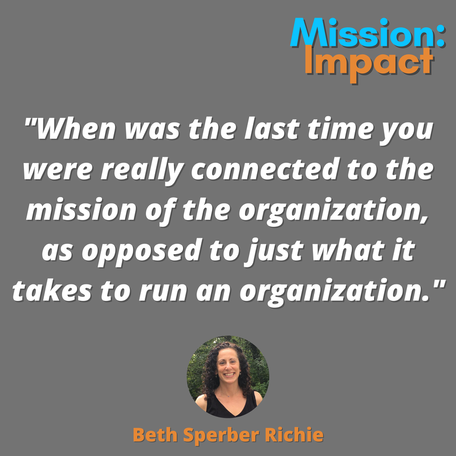Mission: Impact podcast & blog
Build a better world without becoming a martyr to your nonprofit cause
Listen on:
 This week we’re talking to Beth Sperber Richie. We talked about: • What is burn out is and why burn out is so prevalent in the nonprofit sector • What the research shows about rest and productivity for organizations. • What vicarious trauma is and how it impacts nonprofit staff and an organization’s culture. Beth Sperber Richie, Ph.D. is a licensed psychologist and consultant in private practice in the Washington, D.C. area. Dr. Richie works with non-profit leaders on how to sustain their staff and their mission given the grind of social change work. She gives workshops and presentations on managing stress and burnout, vicarious trauma and compassion fatigue, improving cross-cultural communication and counseling skills and setting boundaries for front-line employees. Her workshops focus on practical skills and engaged involvement of all participants. Beth on LinkedIn Click "Read More" for Transcript: When you are used to meeting in person, it is easy to see the disadvantages of online meetings. You are missing out on a lot of body language and other non-verbal cues. Yet the sudden shift to everything online since March 2020 has demonstrated many of the advantages of online meetings. No commute
Saves moneyNot only do your participants save time and money on travel, your organization saves money. You do not need to rent a meeting space and serve the group food. You will need to pay for an online meeting hosting service such as Zoom or Adobe Connect as well as perhaps an online collaboration tool such as Mural or Miro. These costs, however, will be substantially less than what you would have paid for in food, AV rental, printing and other costs of the meeting. It also makes it easier for your nonprofit's volunteers participate. They do not have to donate travel time in addition to the actual time in the meeting or event. Using technology to your advantageThere are lots of ways that the technology itself can help you run an effective meeting.
Want to learn more about how to effectively facilitate online meetings? Join my four-week group coaching program. A new cohort starts in September. Building rapport with people online is one of the things nonprofit leaders often mention as a challenge in online meetings. Yet with some intention it is possible. Connection before content Photo by Anna Shvets from Pexels Photo by Anna Shvets from Pexels A good practice (whether in person or online) is to be sure to take some time at the beginning of the meeting to connect on a personal level before you jump into the meeting agenda. This could include a check in question such as an ice-breaker. Some people cringe when you mention icebreaker. Yet the question does not have to be “what Harry Potter character are you?” or [fill in the blank with a question you got asked at beginning of a meeting that had nothing to do with the issues at hand]. It can be work-related. Especially with groups who do not know each other making the question relatively safe is often a good place to start. What is your super-power? What is the latest app you discovered and love? What are you hoping we achieve today? If the group is large and you are afraid intro’s and icebreakers will take up a chunk of the meeting time, split people into smaller groups (2-4) and have them introduce themselves in their small group. Yet the question does not have to be “what Harry Potter character are you?” or [fill in the blank with a question you got asked at beginning of a meeting that had nothing to do with the issues at hand]. It can be work-related. Creating NormsIf the group is going to be working together for a while, help them have a conversation about how they want to work together. What helps them work effectively in a group? What might get in the way working together online and remotely? How might they address those challenges? It may take a few rounds of brainstorming and refinement to come to a set of agreements that work for everyone. Yet having this list of agreements will help if the group runs into challenges. PauseRapport and trust will be lost if a person in the group does not feel like their voice is being heard. They may feel you are rushing through items without sufficient time for discussion. A good practice as a meeting leader is to pose a question or discussion topic and then take a drink of water. It takes a little bit longer on line for people to jump into the conversation. They may hesitate wondering whether someone else is going to talk and not wanting to interrupt anyone. Taking that drink will prevent you from continuing to talk and gives your meeting participants time to gather their thoughts and respond. Checking inDo you really know whether everyone is with you and in agreement? Check in more frequently with the group to make sure:
Don’t assume silence means agreement. This blog post goes into more detail on checking in. Want to learn more about facilitating effective online meetings? Sign up for my four-week group coaching program on Effective Online Facilitation. Nonprofit organization often value participatory decision making. Yet often nonprofit leaders think the only way to achieve participation is to strive for consensus. Groups often fear working on a consensus basis because they are afraid of the time it will take to make a decision. They are afraid of being caught in a spiral of discussion, more discussion and yet more discussion and no resolution. They may be afraid of this because they may assume that everyone has to be 100% behind a decision for the group to move ahead. When a group is considering an issue, ideally there is a discussion that considers a wide range of options. Then the discussion comes to a clear end point with a decision. Once a decision is made the group moves to action. This image illustrates this ideal. Americans tend to be quite action oriented and in our culture we can get impatient easily, wanting to jump to a decision. And thus more frequently it feels like this: Part of the group thinks a decision has been made and others thinks the item is still up for discussion. And still others may not be clear what decision is on the table. Consensus continuumOnce the nonprofit group is clear about what they are deciding, a useful tool for testing the level of agreement is the consensus continuum. Applying the continuumI was part of a nonprofit board that used this continuum when it was deliberating about a very challenging situation. There was no good solution to the high stakes problem we were facing. There were only several bad choices to choose from. Which bad choice was better than the other? We deliberated for a long time. Deliberation happened over multiple meetings, over multiple weeks. Ultimately we were able to make a decision that everyone in the group could live with even if it was not their preferred option by using this tool. How many people you need to have in the 1-3 zone will depend on how high stakes a decision it is. Using this as a check in can move along even decisions that may seem like they are low stakes but are taking a long time. You may find it is higher stakes for some in the group. There was no good solution to the high stakes problem the nonprofit board was facing. There were only several bad choices to choose from. Which bad choice was better than the other? We deliberated for a long time. Deliberation happened over multiple meetings, over multiple weeks. Ultimately we were able to make a decision that everyone in the group could live with even if it was not their preferred option by using this tool. Making time for processNonprofit groups often want to jump to action and resist taking time on ‘process’ issues. Being clear about how the group makes decisions is a core process issue that rarely gets discussed. Taking the time can actually save the group both time and angst in the long run.
Have a group that needs help with how they are working together? Reach out for a coaching session. |
Categories
All
Archives
July 2024

Grace Social Sector Consulting, LLC, owns the copyright in and to all content in and transcripts of the Mission: Impact podcast, as well as the Mission: Impact blog with all rights reserved, including right of publicity.
|
Telephone301-857-9335
|
info[at]gracesocialsector.com
|
Grace Social Sector Consulting, LLC, owns the copyright in and to all content in, including transcripts and audio of the Mission: Impact podcast and all content on this website, with all rights reserved, including right of publicity.
|